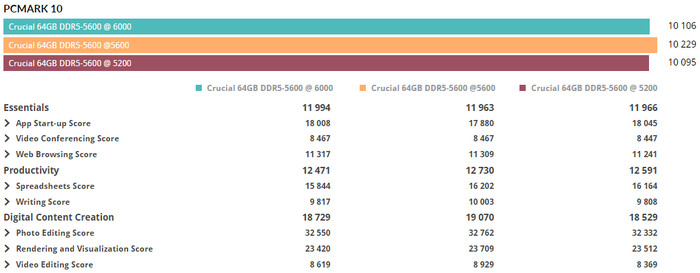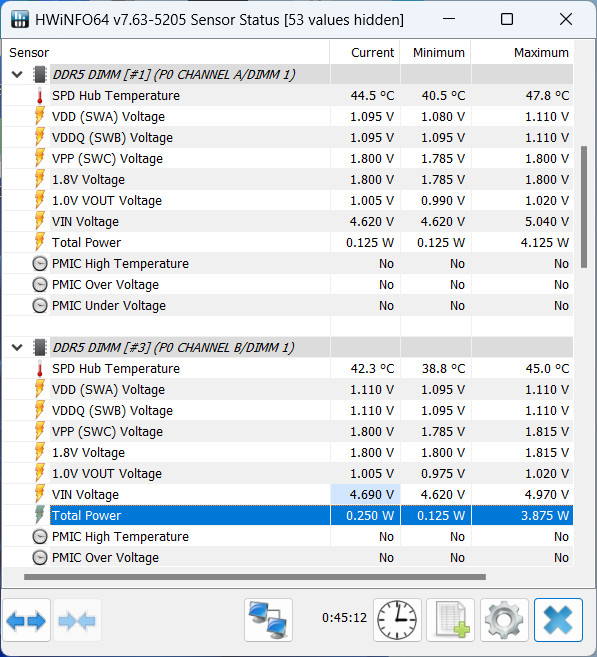Crucial DDR5-5600 64GB
2. Tests
For our tests, we used the following test system
- AMD 7950X CPU + Noctua NH-U12A Chromax.black (2x120mm fans)
- Asus ProArt X670E-CREATOR WIFI Motherboard with the latest BIOS installed (1602 AGESA 1.0.0.7c)
- MSI 4090 Suprim X Graphics Card with v537.34 Nvidia Drivers installed
- Samsung 980Pro 1TB with the latest BIOS NVME SSD
- Seasonic Vertex GX 1000W Power Supply
- Dell S2721QS 4K Monitor @ 60Hz
- Windows 11 Pro Edition + latest updates installed
- Test Stability:
- quick testing 30min OCCT v12 Memory Test
- stable testing Testmem5 absolute(01102021)@anta777.cfg (3 cycles)
Both modules were installed at the B2/B4 channels suggested by the motherboard vendor. We had to manually perform ClearCMOS to get everything started and the memory training for the DDR5 platform with the Asus motherboard isn't long, the first boot came around 20 seconds, and the first power up. After that point, the system is much faster at boot.
After getting the first boot, the Asus motherboard recognized and set the memory initially at DDR5-5200, without enabling any EXPO/XMP profiles. In order to get the higher DDR5-5600 memory speeds, you need to enable the included XMP/EXPO profile.
Getting into Windows 11, we get more information about our memory kit from the CPU-Z software. The DDR5-5600 memory kit was manufactured in 37 week of 2023 and has both EXPO/XMP profiles running at 5200/5600MHz at 1.10V.

Then we used the free latest version of the Thaiphoon Burner which includes more information about the used modules.

The default running speed of the Crucial Pro DDR5-5600 is DDR5-5200

Enabling the XMP/EXPO profile (under BIOS) will get you higher running speeds than the advertised DDR5-5600 speeds.

You could use the Crucial DDR5-5600 up to 6000MHz with the same memory timings as the 5600MHz, however, you need to push the voltage to 1.30~1.35V to get the system stable.

We also tried to lower timings, however, the system was not stable, it probably needs more voltage (1.40V) to get further tight timings, which are not recommended.
AIDA64 Cache And Memory Benchmark (v6.92.6600)
The AIDA64 Cache and Memory Benchmark shows differences between the various speeds, while the highest score comes at the 5600 CL46 stock setting.

The software reports around 77.3ns with the 5600CL46/6000CL46 modes, while it has 80.1ns at the 5200 CL42,
MemoryMark (Performance Test 10.2 Suite)
This test gives an overall score for the installed memory and we can see that the 5600CL46 has the highest memory mark score with 3804 points. The 6000CL46 got 3802 and the 5200CL42 got around 3699 points.

Passing to the well-known GeekBench, this software tests the performance either in single or total cores, and as we can see there is a performance difference in both single/multi-core index scores as memory frequency rises.

We used the latest version of the well-known PCMark10 and we saw some performance differences in the total overall score, after setting the various memory frequencies of the tested memory. The DDR5-5600 gave the highest overall score.

What are the working temperatures of the modules of the Crucial memory? With stock DDR5-5600 working speeds and voltage (1.1V), the modules will work up to 48 Celsius without any heatsink.























